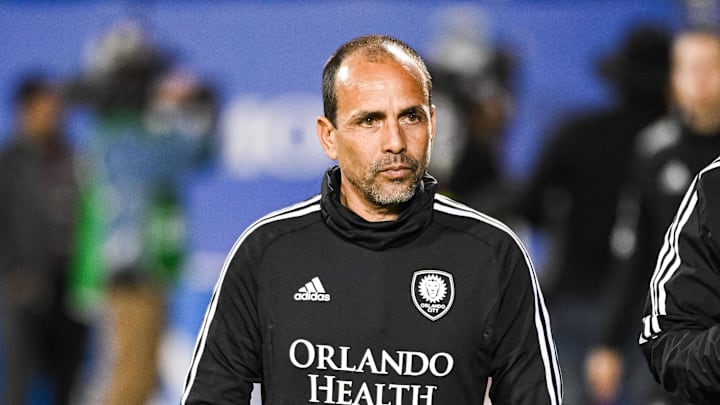I love soccer tactics. I would never call myself an expert on the fine details of the beautiful game, but tactics in soccer (and really all sports) are a fascination of mine.
At the start of every Major League Soccer season, I love seeing how each team wants to play and breaking down their tactical approaches. Orlando City's tactics are extremely intriguing right now after an offseason fraught with change.
The discussions and questions around tactics are only amplified by the small amount of information the public get from preseason scrimmages. Unless you're literally in the building, you don't see how the team is setting up.
With all the caveats and preambles out of the way, let's go through a bunch of different thoughts and speculation about the tactical questions and ideas around Orlando City heading into the 2023 season.
The 4-2-3-1/4-3-3
Under Oscar Pareja, Orlando has nominally used some variation of a 4-2-3-1 shape and a 4-3-3 shape. In both setups, the ideal balance is usually an attacking midfield, box-to-box midfielder and a defensive midfielder.
If that was the way Orlando were to line up, that would likely be a trio of Mauricio Pereyra, new signing Dagur Dan Thórhallsson and César Araújo.
Pareja could also opt for a more pragmatic, defensive approach by playing Wilder Cartagena alongside Araújo in a true double-pivot defensive midfield. This lineup provides more solidity defensively, but loses a lot of creativity and ball progression.
Orlando's current personnel also allows for an even more aggressively on offense. Pereyra occasionally played deeper in the midfield. A trio of Araújo, Pereyra and Designated Player Facundo Torres would provide a ton of creativity and allow for another attacking player on the wing like Gastón González on the field.
Torres is nominally a winger, but he's at his best coming inside and creating centrally and in the half spaces. Given the glut of other talented wingers and forwards on the roster, playing Torres as an attacking midfield gets other attackers on the field.
The young Uruguayan attacker could also play as a No. 10 ahead of a more conservative double-pivot to provide aditional cover.
A back three?
Reports from preseason indicate that Orlando is experimenting with more of a 3-4-3/3-4-2-1 shape.
Based on the last game, here's the shape #OrlandoCity will probably be in tonight vs FIU. https://t.co/F0UJ9Ng3qg pic.twitter.com/0B7vugCTdk
— Austin David (@AustinDavid22) February 5, 2023
Despite the shifted shape on paper, that system is similar to how Orlando played last season, especially in its 4-3-3 alignment. In possession, the Lions typically had three center backs. It usually was Joao Moutinho tucking in for ball control on the left side. Ruan would play as more of a winger on the right side with Torres tucking inside to the half space.
A 3-4-2-1 would be a slight shift to this same approach. Luca Petrasso is an offensively minded left back, and this shift would free him up to get forward, and based on this preseason lineup would get Iván Angulo on the field in a new wingback role.
This lineup allows both wingers --- will likely be Martín Ojeda and Facundo Torres in the first-choice XI -- to tuck inside and serve as more central creators. Both of those players have thrived in those spaces and could form deadly attacking tandems out side with the wingbacks.
If there's a drawback to this set-up, it's the midfield. In effect, there'd be a midfield trio of Pereyra, Araújo and Cartagena. The Araújo/Cartagena duo provides limited ball progression, and Pereyra could struggle with covering ground in a spread out midfield like this.
Thórhallsson could be an excellent fit in this type of system. He profiles as a true box-to-box midfielder capable of covering a ton of ground. Putting him next to either Araújo or Pereyra could help to cover either of their weaknesses.
A two-striker lineup
Orlando City has brought in four different strikers in the last two seasons. DP Ercan Kara leads the way up front. U22 signing Ramiro Enrique was brought in this fofseason. SuperDraft selections Jack Lynn and Duncan McGuire fill out the resrves.
All four of these players have shown significant promise, but in either a 4-3-3 or 3-4-2-1 there's only room for one natural striker. Because of that, Pareja could utilize more two-striker lineups throughout the season.
Enrique in particular could thrive in a system with one of the bigger, target strikers next to him. The young Argentine forward has a ton of tactical flexibility and has shown the ability to run with or without the ball into space.
Partnering Enrique with a natural striker like Kara would create havoc for opposing center backs and add a level of variety to Orlando's attack.
This will not be a primary tactical set up for this Lions this season. Torres and Ojeda are too important to not play as much as possible. Either could potentially play as a No. 10 beneath the two strikers in a 3-5-2, but one of the two DPs would have to be on the bench.
That makes this set-up an excellent late-game tweak or rotational option when the DP wingers need rest or if they get injured. The depth at striker gives Orlando another card up the sleeve if plan A doesn't work or Pareja just wants to shake things up during the dog days of sumer.
